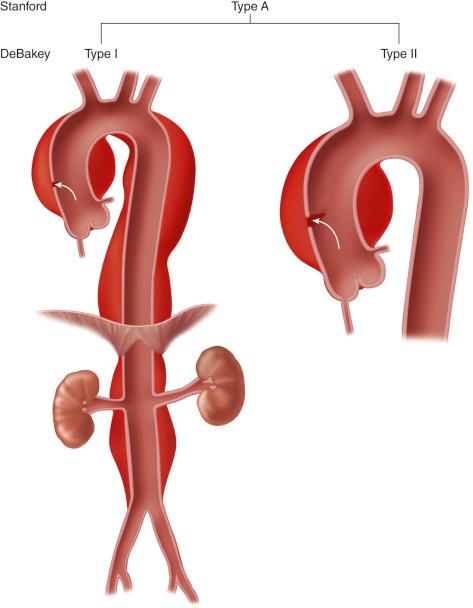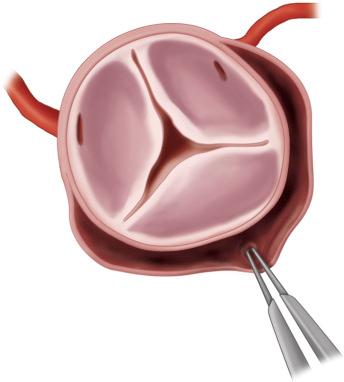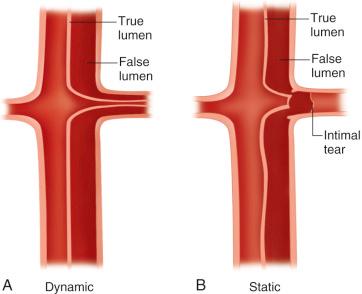Physical Address
304 North Cardinal St.
Dorchester Center, MA 02124
Type A dissection is defined by the presence of a septum creating two lumens within the ascending aorta. The DeBakey classification further divides the Stanford type A classification according to whether the septum is located solely in the ascending aorta (DeBakey type II) or extends distally within the arch and thoracoabdominal aorta (DeBakey type I; Fig. 24.1 ).

The septum is secondary to an intimal tear, with separation of the media creating a true lumen—original aortic lumen lined by intima—and a false lumen, resulting from blood flow separating the media.
In type A dissection, the primary intimal tear is located predominantly at the right anterolateral border of the ascending aorta, just above the sinotubular junction. In less than one-third of cases, the primary intimal tear may be located in the arch or thoracoabdominal aorta. In such cases, the septum in the ascending aorta is secondary to a retrograde extension of the dissection process.
The dissection process may progress to the following:
aortic rupture, usually within the pericardium
extension to branch vessels such as the coronary ostia, arch vessels, and visceral arteries
reentrance into the true lumen, with creation of reentry tears. Tears owing to the shearing of branch vessels of the aorta (natural fenestrations) also contribute to equilibrate the pressure between the true and false lumens.
The dissection process often extends to the aortic root, with loss of commissural support of the aortic valve (mainly the left noncoronary commissure), and may lead to aortic valve malcoaptation and aortic insufficiency ( Fig. 24.2 ).

Organ malperfusion secondary to branch vessel occlusion may supervene after type A dissection. The cause of the malperfusion may be dynamic or static ( Fig. 24.3 ).

Dynamic branch vessel malperfusion is caused by high pressure within the false lumen, with collapse of the true lumen (see Fig. 24.3A ). True lumen branch vessels are hypoperfused because of proximal true lumen aortic collapse or ostial occlusion by the displaced septum. This represents the most frequent mechanism of malperfusion with type A dissection; it is usually relieved by successful reperfusion of the true lumen with operative repair.
Static malperfusion is caused by occlusion of a branch vessel secondary to extension of the dissection process within the branch vessel (see Fig. 24.3B ). A branch vessel hematoma and reentry flap with in the branch vessel resulting in occlusion are examples. Malperfusion often persists following aortic repair.
Combined malperfusion results from a combination of dynamic and static causes.
A diagnosis of acute type A dissection mandates an emergent operative procedure because historic reports have established that up to 1% to 2% of patients die each hour following the insult. Early medical therapy may lessen the risk of early rupture but still mandates emergent operative repair. Operative indications should be individualized in older patients with significant comorbidities or in patients with a severe neurologic deficit and a delayed presentation (> 6 hours) because operative mortality and morbidity rates are very high.
Once the diagnosis is suspected, aggressive medical treatment should be instituted and diagnostic confirmation obtained, followed by operative repair:
Pulse and dP/dt control using either beta blocker–/nitroprusside or a labetalol (Ttrandate) strategy
Invasive monitoring
Pain control
Patients with severe malperfusion, such as visceral ischemia with an elevated lactate level, may initially be managed with an endovascular approach. This can be followed by an open aortic repair once the malperfusion is relieved and the patient is more stable.
Although patients may be directed to the operating room solely on the visualization of a septum within the ascending aorta on transthoracic echocardiography, most patients are diagnosed by computed tomography (CT) angiography. This may provide additional information, such as extent of the dissection and involvement of branch vessels, site of the primary intimal tear, and the presence of pericardial effusion, malperfusion, and aneurysmal dilation.
Coronary angiography is time-consuming and is usually not performed. However, patients with obvious signs of coronary malperfusion and hemodynamic compromise may initially be considered for coronary artery stenting, followed by definitive repair. Patients with a previous coronary artery bypass graft or who have known severe coronary artery disease may be considered for preoperative coronary angiography or cardiac coronary CT on a selected basis.
Become a Clinical Tree membership for Full access and enjoy Unlimited articles
If you are a member. Log in here